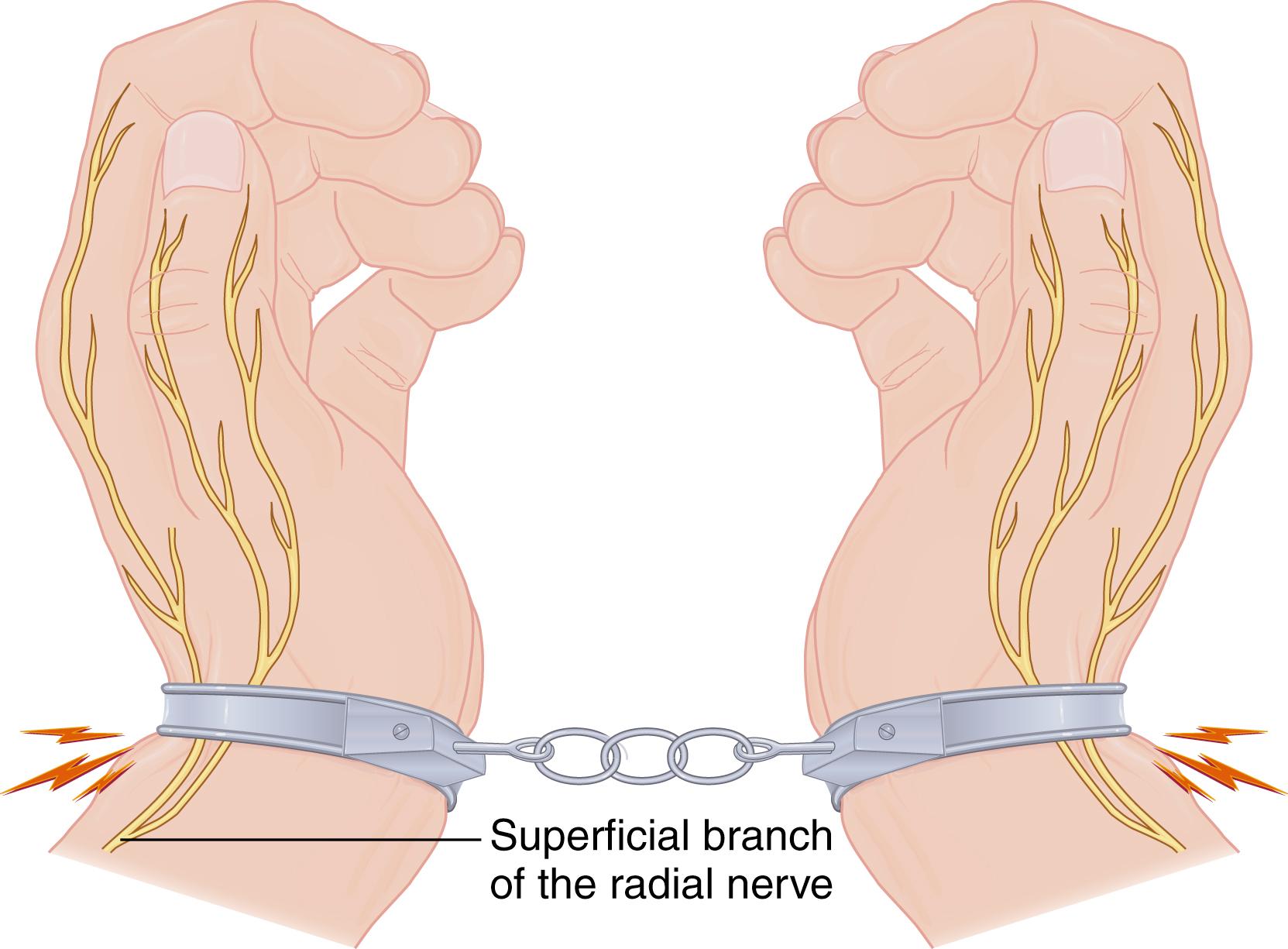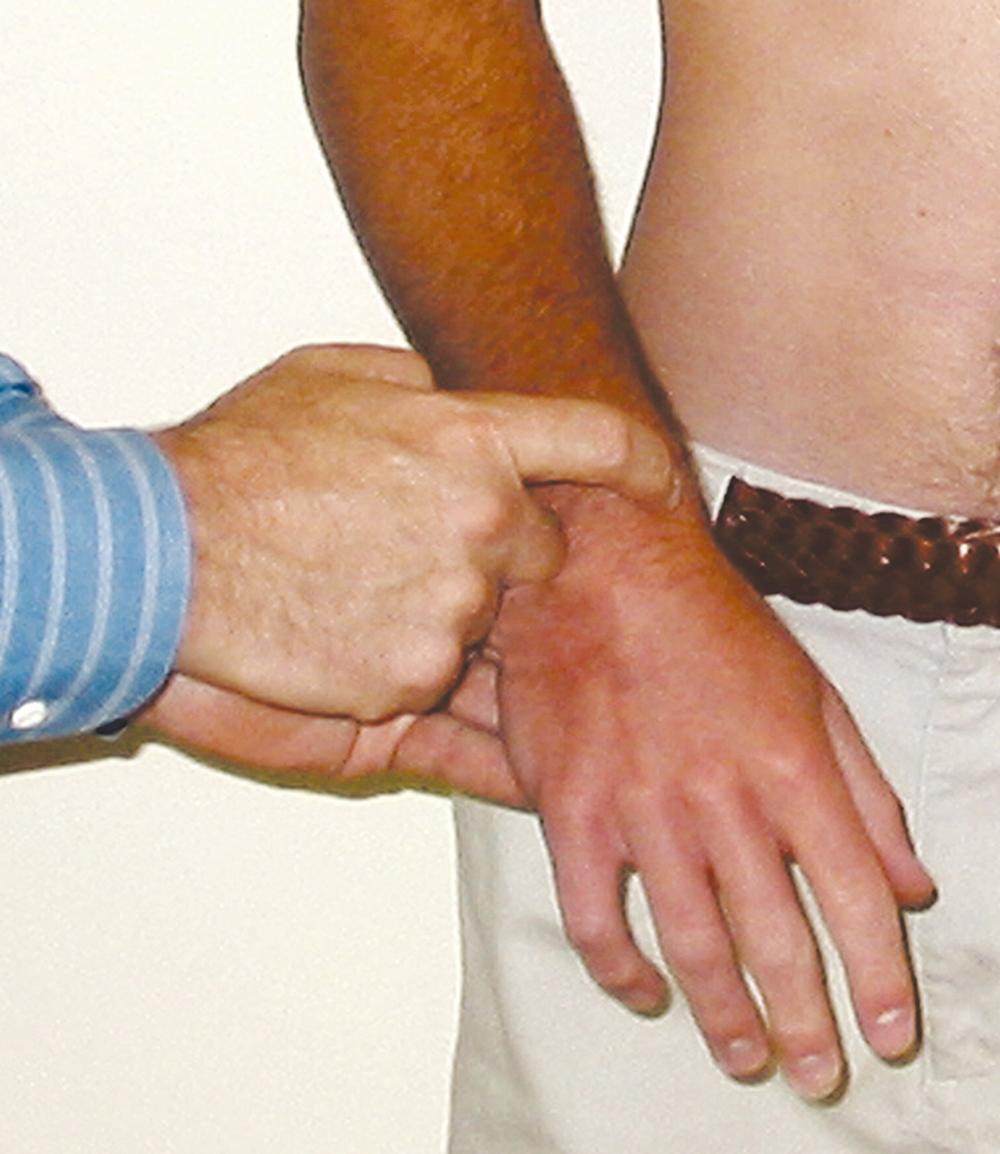Physical Address
304 North Cardinal St.
Dorchester Center, MA 02124
The sensory branch of the radial nerve is particularly susceptible to trauma at the wrist. Fractures or lacerations frequently completely disrupt the nerve, resulting in sensory deficit in the distribution of the radial nerve. The sensory branch of the radial nerve also may be damaged during surgical treatment of de Quervain tenosynovitis. Radial nerve dysfunction secondary to compression by tight handcuffs, wristwatch bands, or casts is common ( Fig. 80.1 ). This entrapment neuropathy is called cheiralgia paresthetica . It is also known as wristwatch and handcuff palsy. Cheiralgia paresthetica manifests as pain and associated paresthesias and numbness of the radial aspect of the dorsum of the hand to the base of the thumb ( Fig. 80.2 ). Because there is significant interpatient variability in the distribution of the sensory branch of the radial nerve from overlap of the lateral antebrachial cutaneous nerve, the signs and symptoms of cheiralgia paresthetica may vary from patient to patient. The onset of symptoms of cheiralgia paresthetica usually occurs after compression of the sensory branch of the radial nerve, as mentioned earlier. Direct trauma to the nerve also may result in a similar clinical presentation, as can tumors involving or compressing the nerve ( Fig. 80.3 ).



Physical findings include tenderness over the radial nerve at the wrist. A positive Tinel sign over the radial nerve at the distal forearm usually is present ( Fig. 80.4 ). Decreased sensation in the distribution of the sensory branch of the radial nerve often is present, although, as mentioned earlier, the overlap of the lateral antebrachial cutaneous nerve may result in a confusing clinical presentation. Flexion and pronation of the wrist, as well as ulnar deviation, often cause paresthesias in the distribution of the sensory branch of the radial nerve in patients with cheiralgia paresthetica. A positive wristwatch test is highly suggestive of the diagnosis of cheiralgia paresthetica. This test is performed by having the patient fully deviate his or her wrist to the ulnar side. The examiner exerts firm pressure on the skin overlying the ulnar nerve ( Fig. 80.5 ). The patient is then instructed to fully flex the wrist. The result is considered positive if this maneuver elicits a paresthesia, pain, or numbness.


Cheiralgia paresthetica often is misdiagnosed as lateral antebrachial cutaneous nerve syndrome. Electromyography can help identify the exact source of neurologic dysfunction. Cheiralgia paresthetica also should be differentiated from cervical radiculopathy that involves the C6 or C7 roots, although cervical radiculopathy generally causes not only pain and numbness but also reflex and motor changes. Furthermore, cervical radiculopathy and radial nerve entrapment may coexist as the so-called double crush syndrome, which is seen most often with median nerve entrapment at the wrist or with carpal tunnel syndrome.
Plain radiographs are indicated for all patients with cheiralgia paresthetica to rule out occult bony disease. On the basis of the patient’s clinical presentation, additional testing may be indicated, including complete blood cell count, uric acid, sedimentation rate, and antinuclear antibody testing. Magnetic resonance imaging and/or ultrasound imaging of the wrist is indicated if joint instability is suspected. The injection technique described later serves as both a diagnostic and a therapeutic maneuver and may be used as an anatomic differential neural blockade to distinguish lesions of the sensory branch of the radial nerve from lesions involving the lateral antebrachial cutaneous nerve.
The radial nerve is made up of fibers from C5-T1 spinal roots. The nerve lies posterior and inferior to the axillary artery in the 6 o’clock to 9 o’clock quadrant. Exiting the axilla, the radial nerve passes between the medial and long heads of the triceps muscle. As the nerve curves across the posterior aspect of the humerus, it supplies a motor branch to the triceps. Continuing its downward path, it gives off a number of sensory branches to the upper arm. At a point between the lateral epicondyle of the humerus and the musculospiral groove, the radial nerve divides into its 2 terminal branches. The superficial branch continues down the arm along with the radial artery and provides sensory innervation to the dorsum of the wrist and the dorsal aspects of a portion of the thumb and the index and middle fingers ( Fig. 80.6 ). The deep branch provides the majority of the motor innervation to the extensors of the forearm. The major portion of the superficial branch passes between the flexor carpi radialis tendon and the radial artery. However, there are a significant number of small branches that ramify to provide sensory innervation of the dorsum of the hand. These small branches also must be blocked to provide complete blockade of the radial nerve.

Become a Clinical Tree membership for Full access and enjoy Unlimited articles
If you are a member. Log in here